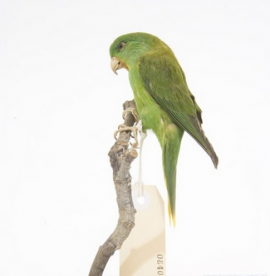Palm Lorikeet |
|
|
Also known as: Green Palm Lorikeet, Vanuatu Lorikeet
Photos
View in GalleryDid You Know?
These parrots are virtually undetectable because of their resemblance to the surrounding foliage. They are only found by their occasional high, shrill calls.Academic Research
Related publications: Charmosyna palmarumSpecies Profile
Genus: Charmosyna | Species: palmarum
Size:
17cm (6.6 in)
Weight:
35g (1.2 oz)
Subspecies including nominate:
one
Colour Adult:
Both adults red on chin, lores, and base of bill (less in female); mantle washed with olive/brown, often missing in female; underwing band absent; green tail with wide yellow tip; orange bill; yellow eye.
Colour Juvenile:
As in female but with orange/brown bill and brown/yellow eye.
Call:
Calls are short and high pitched; more rapid when given in flight. Shrill twittering heard when bird is feeding and softer notes emitted while at rest.
Listen NowMore Information:
Avibase
The Lory Link
Cornell Lab of Ornithology/Birds of the World
Content Sources:
CITES
BirdLife International
Cornell Lab of Ornithology/Birds of the World
A Guide to Parrots of the World, Juniper and Parr, 1998
Parrots of the World, Forshaw, 2006. 2010 edition
Lexicon of Parrots, Thomas Arndt.
ML Media Collection Catalogue 515782 Palm Lorikeet (Charmosyna palmarum), Andersen, Michael J., Torba, Vanuatu, Dec. 6 2014, Cornell Lab of Ornithology.
Photos
View in GalleryDid You Know?
These parrots are virtually undetectable because of their resemblance to the surrounding foliage. They are only found by their occasional high, shrill calls.Academic Research
Related publications: Charmosyna palmarumSpecies Care
Captive Status:
Not found in aviculture.
Longevity:
Not recorded.
Housing:
Enclosure, easily cleaned, 2.5 x 1 x 2m (8 x 3 x 6 ft). Minimum temperature 20C (68F), not less than 24C (75F) during acclimatisation.
Diet:
Lory nectar of thin porridge, honey, pollen, brewer's yeast, vitamins and mineral supplements or commercial nectar; different fruits such as pear, peach, passion fruit and apple; greenfood such as kale and dandelion; different wild edible berries (rowan, pyracanthas and rose hips).
Enrichment:
Not recorded.
Nest Box Size:
Box 20 x 20 x 40cm (10 x 10 x 20 in).
Clutch Size:
Probably 2
Incubation Time:
Not recorded.
Fledging Age:
Not recorded.
Hatch Weight:
Not recorded.
Peak Weight:
Not recorded.
Weaning Weight:
Not recorded.
Photos
View in GalleryDid You Know?
These parrots are virtually undetectable because of their resemblance to the surrounding foliage. They are only found by their occasional high, shrill calls.Academic Research
Related publications: Charmosyna palmarumSpecies Wild Status
World Population:
1500-4000
IUCN Red List Status:
Vulnerable
CITES Listing:
Appendix II
Threat Summary:
A BirdLife “restricted-range” species. Threats include avian malaria, cyclones and natural cycles. Lowland forest, which may or may not be used by this species, is being cleared for agriculture, timber and commercial logging.
Range:
Santa Cruz, Duff and possibly Reef Islands, easternmost Solomon Islands, and Vanuatu, including Banks Islands.
Habitat:
Found above 1000m (3280ft) in undisturbed montane forest, irregularly in lowlands.
Wild Diet:
Feeds on nectar and pollen of various trees, palms, lianas and shrubs, notably from flowers of sago palms (Metroxylon rumphii) and Erythrina; also takes Ficus figs and berries.
Ecology and Behaviour:
Nomadic, traveling widely between feeding sites in pairs and medium-sized flocks. Appears in lowlands sporadically. Pair bonds strong in large flocks.
Clutch and Egg Size:
Possibly 2 eggs
Breeding Season:
Beginning in October, young in December. Nest is in hollow tree limb or trunk.
Photos
View in GalleryDid You Know?
These parrots are virtually undetectable because of their resemblance to the surrounding foliage. They are only found by their occasional high, shrill calls.Academic Research
Related publications: Charmosyna palmarumMembers Only Resources
Please log-in now to find more research, resources and tools.
Not a Member?
Find more great information:
Gain exclusive access to 600+ pages of additional research, seminars and podcasts, specialists to ask your toughest questions, and dozens of other fun resources - when you become a WPT member.
Join Today >>

































